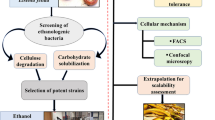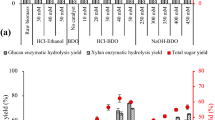Abstract
As a gasoline substitute, butanol has advantages over traditional fuel ethanol in terms of energy density and hydroscopicity. However, solvent production appeared limited by butanol toxicity. The strain of Clostridium acetobutylicum was subjected to mutation by mutagen of N-methyl-N′-nitro-N-nitrosoguanidine for 0.5 h. Screening of mutants was done according to the individual resistance to butanol. A selected butanol-resistant mutant, strain 206, produced 50 % higher solvent concentrations than the wild-type strain when 60 g glucose/l was employed as substrate. The strain was also able to produce solvents of 23.47 g/l in 80 g/l glucose P2 medium after 70 h fermentation, including 5.41 g acetone/l, 15.05 g butanol/l and 3.02 g ethanol/l, resulting in an ABE yield and productivity of 0.32 g/g and 0.34 g/(l h). Subsequently, Acetone-butanol-ethanol (ABE) production from enzymatic hydrolysate of NaOH-pretreated corn stover was investigated in this study. An ABE yield of 0.41 and a productivity of 0.21 g/(l h) was obtained, compared to the yield of 0.33 and the productivity of 0.20 g/(l h) in the control medium containing 52.47 mixed sugars. However, it is important to note that although strain 206 was able to utilize all the glucose rapidly in the hydrolysate, only 32.9 % xylose in the hydrolysate was used after fermentation stopped compared to 91.4 % xylose in the control medium. Strain 206 was shown to be a robust strain for ABE production from lignocellulosic materials and has a great potential for industrial application.










Similar content being viewed by others
References
Atsumi S, Cann AF, Connor MR et al (2008) Metabolic engineering of Escherichia coli for 1-butanol production. Metab Eng 10:305–311
Bowles LK, Ellefson WL (1985) Effects of butanol on Clostridium acetobutylicum. Appl Environ Microbiol 50:1165–1170
Chen M, Zhao J, Xia LM (2009) Comparison of four different chemical pretreatment of corn stover for enhancing enzymatic digestibility. Biomass Bioenergy 33:1381–1383
El Kanouni A, Zerdani I, Zaafa S, Znassni M, Loutfi M, Boudouma M (1998) The improvement of glucose/xylose fermentation by Clostridium acetobutylicum using calcium carbonate. World J Microbiol Biotechnol 14:431–435
Ezeji TC, Qureshi N, Blaschek HP (2007) Butanol production from agricultural residues: impact of degradation products on Clostridium beijerinckii growth and butanol fermentation. Biotechnol Bioeng 97:1460–1469
Gaspar M, Kalman G, Reczey K (2007) Corn fiber as a raw material for hemicellulose and ethanol production. Process Biochem 42:1135–1139
Jones DT, Woods DR (1986) Acetone-butanol fermentation revisited. Microbiol Rev 50:484–524
Khaliq S, Akhtar K, Ghauri MA, Iqbal R, Khalid AM, Muddassar M (2009) Change in colony morphology and kinetics of tylosin production after UV and gamma irradiation mutagenesis of Streptomyces fradiae NRRL-2702. Microbiol Res 164:469–477
Kumar KS, Manimaran A, Permaul K, Singh S (2009) Production of beta-xylanase by a Thermomyces lanuginosus MC 134 mutant on corn cobs and its application in biobleaching of bagasse pulp. J Biosci Bioeng 107(5):494–498
Lee S, Park J, Jang S, Nielsen L, Kim J, Jung K (2008) Fermentative butanol production by clostridia. Biotechnol Bioeng 101:209–228
Lin YL, Blaschek HP (1983) Butanol production by a butanol-tolerant strain of Clostridium acetobutylicum in extruded corn broth. Appl Environ Microbiol 45:966–973
Liu SC (2004) Analysis and measurement in papermaking industry. Chemical Industry Press, Beijing
Liu SQ, Qureshi N (2009) How microbes tolerate ethanol and butanol. New Biotechnol 26(3/4):117–121
Marchal R, Rebeller M, Vandecasteele JP (1984) Direct bioconversion of alkali-pretreated straw using simultaneous enzymatic hydrolysis and acetone butanol production. Biotechnol Lett 6:523–528
Olano C, Lombó F, Mendéz C, Salas JA (2008) Improving production of bioactive secondary metabolites in actinomycetes by metabolic engineering. Metab Eng 10:281–292
Qureshi N, Saha BC, Cotta MA (2007) Butanol production from wheat straw hydrolysate using Clostridium beijerinckii. Bioprocess Biosyst Eng 30(6):419–427
Qureshi N, Ezeji TC, Ebener J, Dien BS, Cotta MA, Blaschek HP (2008) Butanol production by Clostridium beijerinckii. Part I: use of acid and enzyme hydrolysed corn fiber. Bioresour Technol 99:5915–5922
Qureshi N, Saha BC, Dien B et al (2010a) Production of butanol (a biofuel) from agricultural residues: part I—use of barley straw hydrolysate. Biomass Bioenergy 34:559–565
Qureshi N, Saha BC, Hector RE et al (2010b) Production of butanol (a biofuel) from agricultural residues: part II—use of corn stover and switchgrass hydrolysates. Biomass Bioenergy 34:566–571
Wang L, Chen HZ (2011) Increased fermentability of enzymatically hydrolyzed steam-exploded corn stover for butanol production by removal of fermentation inhibitors. Process Biochem 46:604–607
Wu ZF, Bajpai R, Yan W (2008) Screening for ω-1-hydroxy fatty acid over-producing mutants for bioconversion of oleic acid by combining general mutagenesis and specific selection. Biocatal Biotransform 26(5):444–449
Xu H, Jia SR, Liu JJ (2011) Development of a mutant strain of Bacillus subtilis showing enhanced production of acetoin. Afr J Biotechnol 10(5):779–788
Acknowledgments
We would like to express our deep appreciation to the National Key Technology R&D Program (2010AA101606, 2011BAD22B01) for its funding.
Author information
Authors and Affiliations
Corresponding author
Rights and permissions
About this article
Cite this article
Gao, K., Li, Y., Tian, S. et al. Screening and characteristics of a butanol-tolerant strain and butanol production from enzymatic hydrolysate of NaOH-pretreated corn stover. World J Microbiol Biotechnol 28, 2963–2971 (2012). https://doi.org/10.1007/s11274-012-1107-1
Received:
Accepted:
Published:
Issue Date:
DOI: https://doi.org/10.1007/s11274-012-1107-1




